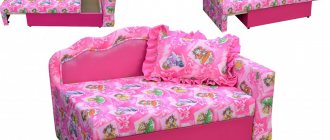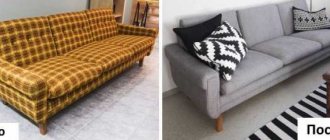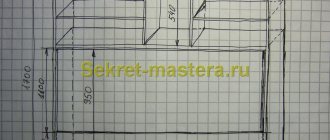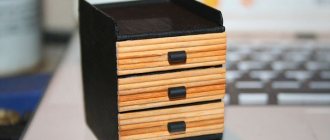Comfort and convenience during sleep are important aspects that allow the body to gain strength at night. The bed and mattress must be comfortable, the purchase of which often causes financial difficulties. Making a mattress with your own hands is an opportunity to save money, use the right materials, and be an interesting job.
We create a comfortable mattress ourselves
This interesting process has a number of advantages. It is simple and does not require additional study of implementation technology. The materials available are available options. You can choose the size, height, and softness of the product yourself.
Creating a sleeping area depends on personal preference. It is important to understand that you can make the following products with your own hands:
- Orthopedic mattress;
- Foam;
- Using pillows.
These are the most common options that do not require special tools and materials that cannot be purchased in the store.
Manufacturing technology
After we have prepared all the necessary materials and tools, we can begin to work.
"Dad is offended." Agata Muceniece about her relationship with Priluchny after the divorce
Rare shot: Viktoria Isakova showed her grown-up daughter from Yuri Moroz (new photo)
Smooth and fresh skin: dermaplaning, or why a woman needs to shave her face
- First of all, take a tape measure and measure the bed, and then take all the necessary measurements for the future mattress.
- In order to make a frame, make a special box. It will prevent the structure from moving back and forth. The thickness of the box itself should vary from five to ten centimeters. We make a box in the form of a rectangle and glue the joints together using special glue.
- And now you need to put the filler itself in the box. If you managed to buy a solid filler, then simply make it the required size and insert it into the box. If you are lucky enough to buy the pieces, then insert the pieces into the frame. Foam rubber should be ten to fifteen centimeters thick.
- If you want to combine different types of fillers, it will be much more difficult for you at this stage of the work. If you want to avoid the mattress rolling back and forth on the surface, it is better to glue the layers of foam rubber together well.
- If you want to use thin rubberized foam, you will simply have a hard time finding it on sale. If you find one, its thickness should be no more than five centimeters.
It is better to make the base from solid elements rather than from pieces.
DIY foam mattress
Foam rubber is a common filler on the modern market. It is accessible and can be purchased by each of us. The second name of the synthetic material is polyurethane foam. Many people often wonder about using polyurethane foam in a mattress - what is it? PPU, foam rubber or polyurethane foam is constantly being improved as a material and it is no longer worth comparing the properties of today's material and the material of ten years ago. Scientists are constantly working on the composition of the material and they have managed to bring its performance closer to the standard safety level.
Currently, a large number of brands of foam rubber are produced; they differ not only in price, but also in quality; the main quality parameter of foam rubber is density. The most valuable brands for use in mattresses are foam rubber of medium and ultra-hardness, viscoelastic foam - they are comfortable, durable and are very popular. Low-quality brands include low-density foam, it is soft and quickly breaks down.
There are a large number of types of this filler, they all differ in their performance properties:
- Elasticity;
- Hardness;
- Densities.
Selection of foam rubber for a mattress (foam rubber density)
The material selected as a filling element meets certain requirements that contribute to obtaining a good result. Foam rubber must be elastic and soft, and quickly return to its original form after use. Quality assessment is determined by the density of the product; for a mattress, values in the range of 25-40 kg/m3 are considered ideal. The selection of filler begins with taking into account its markings.
Here you will find out why foam mattresses are in good demand
Preparation of materials and tools
The purchase of the required materials depends on the choice of purpose of the finished product. For the stationary model, additional spring blocks are purchased. For the portable version, you only need polyurethane foam. Construction using the following materials and tools:
- Dense foam rubber - required to create a frame;
- Filler, which is designated by the markings EL, HR and VE;
- It is possible to supplement the structure with coconut coir or other materials;
- Glue for fixing the product, purchased specifically for foam rubber;
- Fabric (natural materials are great).
Additional tools you will need are a tape measure, a knife, scissors, and a machine for sewing a cover.
Sewing a mattress
Before manufacturing the product, you need to measure the sleeping area. Next, the frame itself is assembled; for this, a body is made of dense polyurethane foam, the thickness of which should be at least 5 cm. The bars of the material must be laid out on a flat surface, then they are glued together. It is recommended to place a stiffer sheet of foam rubber on the top layer; this is more comfortable for the body and back.
Next, the filler is carefully laid, preferably in solid sheets, about 15 cm thick.
Foam rubber in the form of scraps will not be a good filler; the base must be solid.
How to sew a mattress cover?
This is the next step in making a mattress, for which you will need fabric, a sewing machine and threads matched to the color. The filled frame is measured and the parts are cut out, leaving three cm on each side for the seam. The cover must fit snugly to the product and it must be tightened with outside help. It is necessary to have a zipper for comfortable cleaning of the mattress.
It is necessary to select natural fabric as a material, since it is not allergenic.
To keep your homemade mattress clean, you need to sew a mattress cover.
An interesting article about what a topper or mattress pad is, their types
Making a thin foam mattress
A sheet of foam rubber (density not lower than 25) can be easily cut with a sharp knife. Most often, a construction knife with replaceable blades is used for this operation. This is done like this:
- The sheet of foam rubber is marked with a marker (felt-tip pen), and marks are placed.
- Using a wooden plank, all marks are connected by a straight line.
- Under the place of the future cut we place some unnecessary hard cloth (a scrap of board, a piece of thick cardboard, etc.).
- Taking the knife strictly vertically, make the cut with leisurely, precise, strong movements.
- We check the depth of the cut: we push the resulting hole apart with our fingers and cut the foam rubber to the bottom.
If there are a lot of burrs at the cut site, the tip of the blade (or the whole thing) should be replaced. Curvilinear cuts are made in the same way: a pattern is applied, markings are made on it, excess foam rubber is cut off with a vertically mounted knife, the resulting cut will not be ideal, but quite acceptable. If necessary, foam rubber can be easily glued together, the resulting seam will be strong and elastic.
Note! When heated, foam rubber releases cyanide-containing substances that are hazardous to health, affecting the respiratory and nervous systems even in small doses. Therefore, hot cutting of this material at home is categorically unacceptable.
Cover for a thin mattress made of calico or satin
It is acceptable to use ready-made quilted fabric (the composition is more natural, containing cotton), used for making linings or sewing bedspreads. We begin work by taking dimensions: length, width and height. To avoid creating unnecessary seams, we take the fabric as a single piece. Remember that natural fabrics shrink noticeably; after washing, a piece 2 m long may shrink by 10 centimeters. Therefore, it is best to wash the fabric first.
Leave a 1.5 cm seam allowance. To cut the fabric evenly, we wrap the remainder over the main part and even out the edges. Holding it with your hand, slightly pull the fabric towards you with scissors and make a cut.
We fold the piece of fabric along the fold line, rounding the corners as on a mattress. We sew the cover around the perimeter using a sewing machine, using a zigzag or overlock to go around the edges.
On the shorter side we leave a hole for installing a zipper, a space at the edges of 20 to 30 cm. We iron the fabric in this place, and after preliminary basting we sew in a zipper using a machine.
There is almost no sliding of the fabric on the foam rubber, so carefully, without tugging, we pull the cover onto the mattress. We tighten the fabric, straighten the corners, then pick up the folds and tighten them again, after which we fasten the zipper.
Cover for a thin mattress made of upholstery fabric
To ensure that our fabric covering neatly covers the mattress on all sides, after marking the corners, we mark the auxiliary lines of the detailed pattern. Applying the pattern, we round the corners of the upper part, do the same with the corners of the lower part (hems) and draw a straight line at 45°, following through the intersection points of the lines indicating the height of the mattress.
DIY orthopedic mattress
This type of product can also be made at home yourself. Only spring blocks will be required, and as a filler you need to purchase felt and coconut coir. First, the springs are tied together for alignment, then several layers of felt are applied, which are glued together. The next stage is laying out the coir.
The coconut filling should be no thicker than two centimeters.
Additionally, you can add artificial latex, which can be replaced with foam rubber. Alternating layers depends on personal needs.
And for a complete understanding of how to make a mattress at home yourself, you can watch this video:
Pattern and fabric cutting
Mattress patterns can be found on the Internet. Below we describe in detail how to cut the fabric correctly and what rules to follow. Basically, the product is sewn from two parts. The length should be such that the child’s legs fit completely on it and there is still room left. There are more complex options, for example, mattresses with pillows around the perimeter or with additional options. But it is recommended to do the most common thing so that the child feels free and comfortable. For small children, you can additionally sew on the sides and fill them with padding polyester so that the child can hold on softly. They can be equipped with Velcro to secure them to the stroller.
You might be interested in this: The procedure for sewing a bedspread for a sofa with your own hands
How to make a pattern
To draw a pattern, you need to take measurements of the stroller (measure the length and width of the bottom), you need to remember that the bottom has rounded corners. The pattern is drawn on thick or adhesive paper in dimensions 1:1. It is advisable to take measurements several times to make sure that there is no large error.
Pattern for a universal mattress
Cutting out patterns
After completing the drawing, you need to put it in the stroller and check the accuracy, and if necessary, adjust the pattern. Now you can prepare the material:
- To begin with, the fabric is washed so that it shrinks a little, this will make it more convenient to work. Cotton shrinks by 7-10%. It is advisable that the fabric should shrink before starting work, otherwise the dimensions will change after the first wash of the finished mattress.
- The material needs to be ironed well, this will make it more convenient to cut out the parts.
- Place the pattern on the material folded several times (along the grain thread), leaving allowances of 4 cm on three sides, and for the last 10 cm to sew a zipper into it;
- Now you can cut out the mattress parts.
It is recommended to work with a fabric roller or sharp scissors; if necessary, process the edges using an overlocker so that the fabric does not fray.
Square stitch
How to sew a mattress cover?
This part perfectly protects the mattress from dirt and reduces wear. You can make the model in the form of a regular bag; all you need to do is take the fabric and wrap the mattress, and then sew the seams. A more complex option is a sheet with an elastic band; this requires sewing it along the edge of the cut fabric. The material for the product is selected to be wear-resistant and easy to clean.
How much fabric will you need?
To correctly calculate the material, you need to measure the width of the stroller with a centimeter. Calico is usually more than 1 meter (1.5 or 2 m).
Baby product with pillow
Wide fabric is intended for sheets, so it is not recommended to buy it. The width of 1.5 meters is perfect for sewing a mattress into a stroller. With this width, one length of the mattress + 12 cm for bending and adding a zipper will be enough. If you need a 90 cm mattress, then you need to purchase approximately 110 cm of material, since after washing it may shrink a little.
You may be interested in this: Patterns, sewing and sewing a stand-up collar to a shirt
The length and width of the mattress, its appearance must exactly match the bottom of the stroller, otherwise the mattress will fidget and be removed, which is why it will quickly deform. It is always better to take extra material, and from the leftovers you can make some kind of bag for baby bottles or wet wipes. For especially young children, it is advisable to make additional pillows under the head to make it comfortable to be inside.
How to make a mattress harder or softer?
It is important to understand that if you feel discomfort in your sleep due to an uncomfortable mattress, you need to make adjustments to it.
It is possible to make the mattress softer or harder. This is done using a mattress pad. To increase rigidity, coconut coir is used as a filler, and for additional softness, foam rubber can be added. The thickness of the product should not exceed 10 cm, otherwise discomfort will occur. Considering the capabilities of a modern person who is not limited in purchasing materials for his experiments, sewing a mattress and its accessories is a simple task that requires only perseverance. The main thing is to choose the right insides of the product, purchase high-quality fabric for finishing and do the work carefully and carefully. The process itself will not cause difficulties, and even children can participate in some processes. It is important to remember that the finished product must be thoroughly dried in the fresh air.
How to make a springless latex mattress with merino wool
To work you will need:
- a case of suitable sizes with a zipper;
- merino wool;
- latex base;
- scissors.
On a sufficiently large surface, roll out the finished cover, which is easy to make with your own hands. Having opened it along the perimeter, the upper part is folded back.
Merino wool is cut into pieces of the required size with your own hands, and the first layer is laid out.
The second layer is also merino wool.
It is recommended to buy latex according to the size of the future product. You shouldn't cut it with your own hands.
Merino wool is rolled out again on top of the latex. You can add another layer of the same type to increase the softness of the product.
Now close the cover, carefully tucking in the layers with your own hands.
This is how easy it is to make mattresses with your own hands for yourself and your friends.











